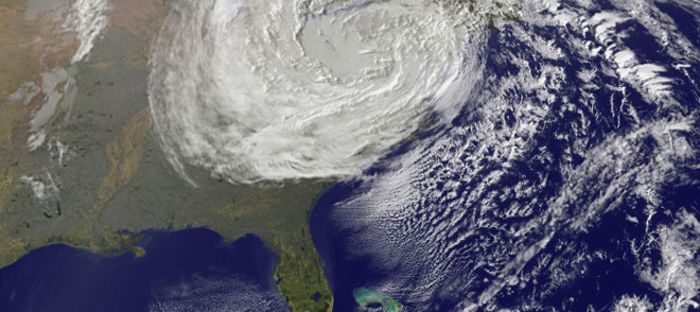Other East Coast Storms Matched Or Exceeded Superstorm Sandy's Power

(ISNS) -- It may be difficult to imagine, but Superstorm Sandy, which struck the east coast of the U.S. on October 29, 2012, was not the most intense storm to strike the New York and New Jersey area in the last 200 years. According to Jeffrey Donnelly, a researcher at Woods Hole Oceanographic Institution in Mass., sediment records show that there have actually been several storms with higher winds in the past 1,500 years.
During a group of talks dedicated to Sandy-related research at last week's meeting of the American Geophysical Union in San Francisco, Donnelly said that although Sandy was a devastating storm, the historical record shows that "it could have been much worse."
A sediment record from Crab Meadow, N.Y. showed at least 12 storms that were probably larger than Sandy in the past 1,500 years, which was largely confirmed by a record from Salt Pond, Mass.
Donnelly also used a computer model of hurricane development to reconstruct the biggest of those storms, which occurred in 1821. He found that it was probably a category 3 hurricane that moved along the Eastern Seaboard at about 35-40 mph. Its storm surge was about 13 feet and it hit right at low tide.
This contrasts with Sandy, as the more recent storm's highest surge coincided with high tide. The difference in water level was actually fairly small, as sea level is about a foot higher now than it was in 1821. Sandy also moved much slower, so its effects lingered in place for a longer time. It was also a large storm in terms of its geographic size.
However, despite the massive damage of property along the shoreline and downed power lines inland, a stronger storm would have had even more devastating effects farther inland, due to higher wind speeds, said Donnelly.
He noted that development of the Atlantic Coast accelerated greatly during the 20th century, which appears to have been a relatively quiet period for hurricane strength. And a stronger storm is possible, with or without a large rise in global temperature.
Sign up for the Live Science daily newsletter now
Get the world’s most fascinating discoveries delivered straight to your inbox.
In terms of what shoreline records from about the last 1,500 years reveal, the 1821 storm was "probably close to the worst-case example," Donnelly said. "We don't even have to look at doomsday global warming scenarios."
"Sandy was big. It was powerful. It was not unprecedented," said Bill Patzert, a climatologist at NASA's Jet Propulsion Laboratory, in Pasadena, Calif.
Although it may seem that storms in the U.S. are becoming ever more costly, Patzert said that several factors have contributed to the high cost of natural disasters in recent years.
"With increasing population density and more infrastructure, these natural disasters, which are not without precedent, are going to be costlier, because of density," said Patzert.
He added that the development in and around Miami, along with the Florida Keys, may make those areas among the country's most vulnerable to a strong storm.
Inside Science News Service is supported by the American Institute of Physics. Chris Gorski is a Senior Editor for Inside Science and tweets at @c_gorski.












